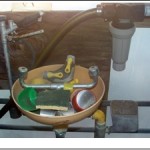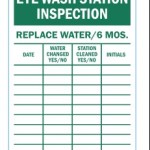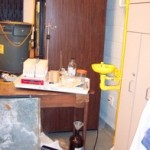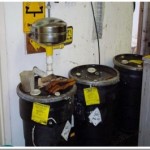 During the past year or so while conducting 5 Star Health & Safety Management System™ Audits, I have been astounded at the number of chemical plants and laborites where employees had not practiced, and could not use the provided eyewash stations.
During the past year or so while conducting 5 Star Health & Safety Management System™ Audits, I have been astounded at the number of chemical plants and laborites where employees had not practiced, and could not use the provided eyewash stations.
My normal auditing practice, is to request an employee to participate in a short practical exercise, usually within 5 feet of an eyewash station, I place a blindfold (issued on the plane) covering the eyes of the volunteer, then turn him/her around 3 or 4 times, then pour an egg cupful of water into his / her face, saying it is a caustic mixture, on alternate audits, I pour whipping cream onto goggles before cleaning off in eyewash.
What happens next is that the person cannot find the eyewash, unless guided, then they cannot activate the eyewash, sometimes they have a valve, which is stupid and illegal, but often found, rarely have employees practiced using the eyewash, so as illustrated, the opportunity of not being able to effectively use the eyewash is greatly increased.
A chemical eye injury is something to avoid at all costs; it’s a painful and frightening experience and one that may leave a person blinded for life. So if your workers are exposed to hazardous chemicals and other substances, it’s imperative that you do everything you can to ensure that your emergency eyewash stations meet the required safety standards to best protect workers. Here are some suggestions that Dr. Bill Pomfret; President of Safety Projects International Inc. recommends.
Pomfret states that many eyewash stations are obstructed, do not have the correct demarcation, have unauthorized items inside, are not on a formal inspection or planned maintenance program, employees have never been properly instructed, practiced or seen a demonstration of its use, or been informed to was eyes for at least 3 minutes.
1. Keep the doors open. Don’t place an emergency eyewash station behind a closed or locked door. While the station may be used infrequently, remember that when it’s needed, someone’s vision is on the line. And every second counts.
2. Don’t hang the unit at an angle. This can interfere with the proper flow of flushing fluid and may force an injured person to stand in an uncomfortable position to flush properly for between 15 and 20 minutes.
3. Don’t block access. Avoid storing anything underneath or in front of an eyewash unit, which can block an injured worker’s ability to reach or stand comfortably at the station.
4. Watch the fluid’s temperature. Don’t allow the flushing fluid to become too hot or too cold. Storing eyewash in extremely hot or cold environments can cause flushing fluid’s temperature to rise or fall outside of both CSA and ANSI’s stated standard for tepid water. Flushing eyes with scalding or ice-cold solution can cause further damage to an already compromised eye.
5. Fill the unit properly. Avoid mistakes when mixing flushing fluid. Both CSA and ANSI requires that the unit be filled with flushing fluid or the pre-packaged fluid provided by the manufacturer. Always prepare fluid according to manufacturer’s instructions.
6. Clean thoroughly after use. Don’t forget to clean, disinfect, rinse and completely dry the unit after each activation, including hoses, nozzles and nozzle covers (this doesn’t apply to sealed-fluid cartridges). Any lingering cleaning chemicals or particles may harm the next user’s eyes. When the wrong chemicals mix, the fluid may turn brown or another color and colored fluid is never usable.
7. Don’t cover the unit. Don’t place a plastic bag or other makeshift cover over the unit to keep dust or particles out. This can hinder an injured person’s ability to properly activate the unit in a single motion and start the flow in one second or less.
8. Mind the shelf life. Avoid using expired flushing fluid. Like any standing water, eyewash fluid can grow bacteria that may be harmful to eyes. Be sure that someone is responsible for checking stations’ expiration dates and refilling/replacing them according to the manufacturer’s guidelines. Generally, according to ANSI Z358.1-2009, weekly flushing is required for plumbed stations, every three to six months for tank-style fluid stations and every two to three years for sealed-fluid cartridges and bottles.
9. Install the unit correctly. Don’t install an eyewash unit without carefully following the manufacturer’s instructions. Stations vary and have precise installation instructions to ensure proper performance, never use a valve for turning on, only a touch lever at the correct height, including installation height, the rate of fluid flow, required spray pattern and much more.
10. Don’t alter or tamper with the unit. Again, the manufacturer’s instructions are the only ones that should be followed. Don’t try to re-route hoses, change nozzles or otherwise compromise the station’s performance.
Eyes are one of the most vulnerable parts of the body, in demonstrating the eye’s vulnerability, I crack two eggs onto a saucer, and then put one drop of a chemical into the yoke, and the dispersion will be remembered by everyone present.
By understanding how to use emergency eyewash properly, your facility can ensure greater workplace eye safety. And that’s a clear benefit everyone can see.
Bio:
By Dr. Bill Pomfret, MSc. FIOSH, RSP, FRSH
President, Safety Projects International Inc.
Kanata, Ontario, Canada K2K 1X4.
Tel: (613) 2549233. E-mail pomfretb@spi5star.com







